THE
BRITISH EMPIRE AND
GLOBALIZATION: A FORUM
Niall Ferguson, P.J. Marshall, Robert E. Lucas,
Jr., Andrew Porter, and Andrew J. Bacevich
With two books and a
British television series, Niall Ferguson has placed a spotlight on the history
of the British Empire and its relevance for
making sense of the contemporary world. Here he considers the empire’s impact on
the global economy. P.J. Marshall, Robert E. Lucas, Jr.,
Andrew Porter, and Andrew
Bacevich respond to his essay, followed by
Ferguson’s concluding
reply.
British Imperialism Revisited: The Costs and Benefits of
“Anglobalization”
by Niall
Ferguson
It is fair to say
that recent economic history has not been kind to the British
Empire. According to one influential school of thought, late
19th-century capital exports to the country’s numerous colonies diverted
resources away from the modernization of British industry. Some scholars have
questioned whether it was even economically rational for the investors
themselves.[1] Patrick O’Brien has argued that after around
1846 Britain
could have withdrawn from empire with impunity, and reaped a “decolonization
dividend” in the form of a 25% tax cut. The money taxpayers would have saved as
a result of a Victorian decolonization could have been spent on electricity,
cars, and consumer durables, thus encouraging industrial modernization at
home.[2]
Such negative
assessments of
Britain’s
relationship to the empire sit somewhat uneasily alongside the large
“nationalist” literature on the impact of empire on
Britain’s
colonies, notably
India. In the
words of B. R. Tomlinson, “the suggestion remains that British rule did not
leave a substantial legacy of wealth, health, or
happiness to the majority of the subjects of the
Commonwealth.”[3] Numerous authors have insisted that the
principal consequence of British rule in the Indian subcontinent was a legacy of
“underdevelopment.” Can it really be that the empire was economically bad for
both Britain and
her colonies? By drawing on the recent economic literature on globalization,
past and present, this essay argues otherwise.
* * *
In an influential
paper published in 1995, Jeffrey Sachs and A. M. Warner demonstrated
conclusively that one of the principal reasons for widening international
inequality in the 1970s and 1980s was protectionism in less developed economies.
In their words, “open economies tend to converge [on the developed economies],
but closed economies do not. The lack of convergence in recent decades results
from the fact that the poorer countries have been closed to the world.” When
they compared per capita Gross Domestic Product (GDP) growth among developing
countries, they found that “the open economies grew at 4.49% per year, and the
closed countries grew at 0.69% per year.” Sachs and Warner’s findings have been
widely interpreted as making the case for present-day “globalization.” However,
their findings also have important historical implications. As the authors note,
in the previous era of globalization—conventionally seen as the period from the
mid 19th century until the First World War—economic openness was imposed by
colonial powers (principally, of course, Britain) not only on Asian and African
colonies but also on South America and even Japan.[4]
A similar point can
be made with respect to flows of labor. Jeffrey Williamson and others have
emphasized the importance of international migration (or the restrictions on it)
in determining the extent of international inequality. The more free movement
there is of labor, the more international income levels will tend to converge.
One reason that modern globalization is associated with high levels of
inequality is that there are so many restrictions on the free movement of labor
from less developed to developed countries.[5] This too has obvious implications for the
history of the British Empire, which actively promoted
emigration to at least some of its colonies, and certainly did nothing to heed
the migration of British people wherever they wished to go.
Consider also the
evidence on international capital flows, another key component of globalization.
Development economists have spent many decades trying to work out how to raise
the level of investment in backward agrarian societies. The most obvious
solution has been for them to import capital from where it is plentiful, namely
the developed world. According to the simple classical model of the world
economy, this should happen naturally: capital should flow from developed to
less developed economies, where returns are likely to be higher. But as
Robert Lucas pointed out, with respect to the
United States
and India in the
1970s, this does not seem to happen in practice.[6] Although some measures of international
financial integration seem to suggest that the 1990s saw bigger cross-border
capital flows than the 1890s, in reality most of today’s overseas investment
goes on within the developed world. In 1996 only 28% of foreign direct
investment went to developing countries; by 2000 their share was less than a
fifth. The overwhelming majority takes place between the
United States,
the European Union, and
Japan. Investors
in the developed world prefer to invest in countries which already have high
levels of per capita GDP, which is one reason why increased capital flows in
recent decades seem to have been associated with widening international
inequalities.
As Michael Clemens
and Jeffrey Williamson have shown, there was something of a “Lucas effect” in
the first era of globalization, in that “about two-thirds of [British capital
exports] went to the labor-scarce New World where only a tenth of the world’s
population lived, and only about a quarter of it went to labor-abundant Asia and
Africa where almost two-thirds of the world’s population lived.”[7] Nevertheless, the share of British capital
going to poorer countries was still significantly larger than it is today.
According to Maurice Obstfeld and Alan Taylor, in 1997
only around 5% of the world stock of capital was invested in countries with per
capita incomes of 20% or less of
U.S. per capita
GDP. In 1913 the figure was 25%. They also estimate the share of developing
countries in total international liabilities at 11% in 1995, compared with 33%
in 1900 and 47% in 1938. Those figures are at least suggestive of the
possibility that the existence of formal empire encouraged investors to put
their money in less developed economies (see Figure 1).[8]
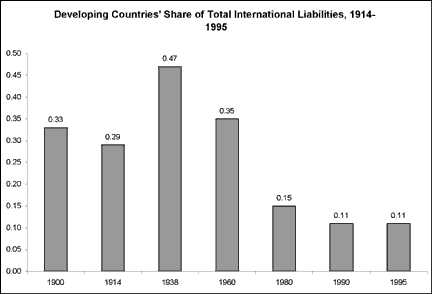 Figure
1
Figure
1
Finally, we need to
consider recent empirical work on the institutional and political preconditions
for growth. In a cross-country study of postwar economic growth, Robert Barro concluded that there were six significant variables
that were likely to influence a country’s economic performance. The first was
the provision of secondary and higher education; the second was the provision of
health care, since there is a correlation between growth and life expectancy;
the third was the promotion of birth control; the fourth was the avoidance of
“non-productive government expenditures,” since “big government is bad for
growth”; the fifth was the enforcement of the rule of law; and the sixth was the
avoidance of inflation above 10% per annum.[9] David Landes, in
his Wealth and Poverty of Nations, has come to similar conclusions,
arguing that “the ideal growth-and-development” government would: secure rights
of private property; secure rights of personal liberty; enforce rights of
contract; and provide stability and fairness in an efficient, moderate
fashion.[10]
It requires only a passing familiarity with the nature of British
colonial administration to recognize that at least some of these were among its
defining characteristics. To be sure, British colonial rule was not democratic
(outside the “white
dominions”—Canada,
Australia, and
New Zealand).
But as both Barro and Landes
observe, democracy does not correlate especially closely with economic
performance.
There is a
significant discrepancy between the modern literature on economic growth and the
historical consensus that the British Empire was
economically deleterious. A striking number of the things currently recommended
by economists to developing countries were in fact imposed by British rule.
There was, as Alan Taylor has suggested, a “London
consensus” not unlike the “Washington consensus” of our own time, with the
difference that the International Monetary Fund cannot rely on the services of
the Royal Navy to enforce its recommendations. Unless the economists have got it
seriously wrong, there is at least a prima facie case that the British
Empire was economically beneficial, not only to Britain herself, but also to her
empire—and perhaps even to the world economy as a whole.
* * *
Let us begin with
world trade and tariffs. In an ideal world, of course, free trade would be
naturally occurring. But history and political economy tell us that it is not.
For most of the 19th century, free trade spread because of
Britain’s power
more than
Britain’s
example. From the 1840s until the 1930s, the British political elite and
electorate remained wedded to the principle of laissez faire, laissez
passer—and the practice of “cheap bread.” That meant that—certainly from the
1870s—British tariffs were significantly lower than those of her European
neighbors; it also meant that tariffs in much of the British
Empire were also kept low. Abandoning formal control over
Britain ’s
colonies would almost certainly have led to higher tariffs being erected against
British exports in their markets, and perhaps other forms of trade
discrimination.
The evidence for
this need not be purely hypothetical: it is manifest in the highly protectionist
policies adopted by the United
States and
India after they
secured independence, as well as in the tariff regimes adopted by
Britain ’s
imperial rivals France,
Germany, and
Russia after the
late 1870s. Whether one looks at the duties on primary products or manufactures,
Britain was the
least protectionist of the imperial powers. In 1913 average tariff rates on
imported manufactures were 13% in Germany, over 20% in France, 44% in the United
States, and 84% in Russia. In
Britain they
were zero.
According to
Michael Edelstein, the economic benefit to
Britain
of enforcing free trade could have been anywhere between 1.8 and 6.5% of the
Gross National Product (GNP).[11] But what about the benefit to the rest of
the world? In the words of Sir John Graham,
Britainwas “the
great Emporium of the commerce of the World.” Its domestic market and much of
its empire were more or less open to all comers to sell their wares as best they
could. The evidence that
Britain ’s
continued policy of free trade was beneficial, in a protectionist world, to her
colonies seems unequivocal. Between 1871-75 and 1925-29, the colonies’ share of
Britain’s
imports rose from a quarter to a third. More generally, as Jeffrey Williamson
has argued, it was (mainly British) colonial authorities that resisted
protectionist backlashes to the dramatic falls in factor prices caused by late
19th-century globalization.[12]
In the same way,
there would not have been so much international mobility of labor—and hence so
much global convergence of incomes before 1914—without the British
Empire. True, the independent United
States was always the most attractive
destination for 19th-century emigrants. But as American restrictions in
immigration increased, the significance of the white
dominions—Canada,
Australia, and
New Zealand—as a
destination for British emigrants grew markedly, attracting around 59% of all
British emigrants between 1900 and 1914, 75% between 1915 and 1949, and 82%
between 1949 and 1963. Nor should we lose sight of the vast numbers of Asians
who left India
and Chinain the
19th century to work as indentured laborers, many of them on British plantations
and mines. Perhaps as many as 1.6 million Indians emigrated under this system,
which lay somewhere between free and unfree labor.
There is no question that the majority of them suffered great hardship; many
indeed might have been better off staying at home. But once again we cannot
pretend that this mobilization of cheap and probably underemployed Asians to
grow rubber or dig gold had no economic significance (see Figure 2).
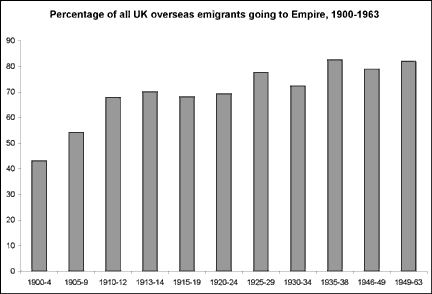
Figure 2
Similar arguments
may be advanced about
Britain's role
as a capital exporter. As is well known, from the mid-19th until the mid-20th
century, Britain
acted as the world’s banker, channeling colossal sums of British (and other
European) savings overseas. By 1914 total British assets overseas amounted to
somewhere between £3.1 and £4.5 billion, while the British GDP was £2.5 billion.
Compared with the other major capital exporters of the period,
Britainsent a
remarkably high proportion of her savings to overseas economies. To be sure,
around 45% of British investment went to the
United States
and the dominions. But 16% of British foreign investment went to
Asiaand 13% to Africa, compared
with just 6% to the rest of Europe. Taking British
investment as a whole, between 1865 and 1914, as much went to
Africa, Asia, and Latin
America (29.6%) as to the
UK itself
(31.8%). This pattern was surprisingly little changed by the effects of the
First World War and the Great Depression. As late as 1938, around 18% of British
overseas assets were in Asia, and 11% in
Africa. As is well known, British investment in
developing economies principally took the form of portfolio investment in
infrastructure, especially railways. But the British also sank considerable (and
not easily calculable) sums directly into plantations to produce new cash crops
like tea, cotton, indigo, and rubber.
Investing money in
faraway places is risky: what economists call “informational asymmetries” are
generally greater the further the lender is from the borrower. Less developed
economies also tend to be rather more susceptible to economic, social, and
political crises. Why then were British investors willing to risk such an
exceptionally high proportion of their savings by purchasing securities or other
assets overseas? One possible answer is that the adoption of the gold standard
by developing economies offered investors a “good housekeeping seal of
approval.” To be precise, as Michael Bordo has shown,
going onto gold reduced the yield on government gold-denominated bonds by around
40 basis points.[13] It is certainly the case that before 1914
adoption of the gold standard was as good a way of obtaining cheap loans as
membership in the British Empire—though it must be remembered that many
countries went onto gold (which was, after all, a sterling standard devised in
London) precisely because they were British colonies.
Yet there is a need
to distinguish here between anticipated and actual returns on overseas
investments. For the period 1850 to 1914, anticipated (ex ante) returns
were not significantly lower on colonial bonds than they were on other foreign
bonds. But the same cannot be said of the actual (ex post) returns. If
one takes an average of the three colonial countries in the sample, the
anticipated yield was 5.3%, compared with 4.7% for the three South American
countries. But the actual returns were significantly different: 4.7% as against
2.9%. This helps explain why, when the same countries returned to the bond
market in the interwar years, they paid significantly different risk premia. On average, the ex ante returns Latin
American borrowers had to offer investors were 270 basis points higher than
those on new colonial issues. Even so, actual returns on Latin American bonds
were once again worse than expected and worse than those on colonial bonds (see
Figure 3).
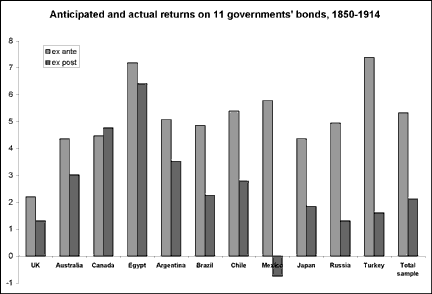 Figure 3
Figure 3
In other words,
experience showed that money invested in a de jure British colony such as
India, or in a
colony in all but name like
Egypt,
was more secure than money invested in an independent, albeit informally
“colonized” country such as
Argentina. This
was because the commitment to gold was a “contingent commitment”; it was
essentially voluntary and could be suspended in the event of an emergency such
as a war.[14] Gold standard members who were otherwise
sovereign states could not only suspend gold convertibility of their currencies;
they could also default on their debts. To varying degrees and at various times,
Argentina,
Brazil,
Chile,
Mexico,
Japan,
Russia, and
Turkey all did
precisely that. Membership in the empire was quite different. British colonies
were unlikely to suspend convertibility and not much more likely to default than
Britain herself.
By the 1920s, membership in the empire was therefore confirmed as a better “good
housekeeping seal of approval” than gold (see Figure 4).
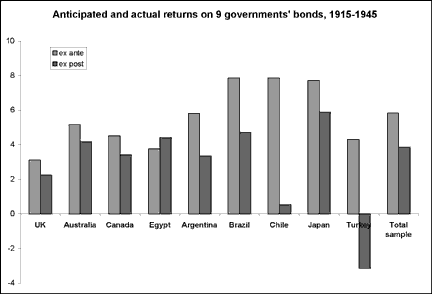 Figure 4
Figure 4
That imperial
membership offered better security to investors than mere adoption of the gold
anchor is not surprising. There were a variety of explicit legal guarantees
offered by the Colonial Loans Act (1899) and the Colonial Stock Act (1900),
which gave colonial bonds the same “trustee status” as the benchmark British
government perpetual bond, the “consol.” Over and above that, there was the
cast-iron commitment of colonial governors and administrators to the principles
of Gladstonian finance. It was inconceivable, declared
the governor of the Gold Coast in 1933, that the interest due on Gold Coast
bonds should be compulsorily reduced: why should British investors “accept yet
another burden for the relief of persons in another country who have enjoyed all
the benefits but will not accept their obligation”? Even colonial constitutions
had been drafted with at least one eye on creditor preferences.[15]
This therefore
explains why an increasing share of British overseas investment ended up going
to the empire after the First World War. In the period from 1856 to 1914, around
two-fifths (39%) of British overseas capital went to the empire, compared with
three-fifths (61%) to the rest of the world. But after the First World War, the
tables turned. Between 1919 and 1938, the empire got two-thirds, the rest got a
third. Nor is it surprising that more than three-quarters of all foreign capital
invested in sub-Saharan Africa was invested in British
colonies (see Figure 5).[16]
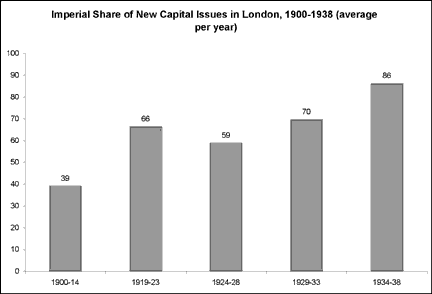
Figure 5
P. J. Cain and A.
G. Hopkins lay great emphasis, in their path-breaking history of British
imperialism, on the dominant role played by the City of
London, with its ethos of
“gentlemanly capitalism.” In both the formal and the informal empire, they
argue, finance came first, and British export industries a poor second. They do
not address how the policy of prioritizing overseas investment affected the rest
of the world. On the strength of the evidence I’ve presented here, it seems
reasonable to conclude that it offered at least the opportunity of economic
convergence. For in order to ensure that loans to developing economies were
repaid, British policy makers were prepared to go to considerable lengths,
ultimately allowing a system of differential tariffs to evolve which gave
colonial manufacturers easier access to the British “home” market than British
manufacturers enjoyed to colonial markets.
Intention and
outcome are two different things. The British did not see the economic
development of Asia and Africa as
their primary concern, though they sometimes paid lip service to the idea. As we
shall see, they would have acted rather differently in
India, if
development had been the paramount objective. Nevertheless, the intended
policy of financial rather than industrial domination of the world economy had
secondary positive outcomes alongside the primary outcome of ensuring that
investors got their interest and principal. Under the right circumstances, this
policy was conducive to rapid economic growth on the periphery—more so than a
policy which would have put the interests of British industrial exports first.
* * *
The results of
“Anglobalization” were in many ways astounding. The
combination of free trade, mass migration, and unprecedented overseas investment
propelled large parts of the British Empire to the
forefront of world economic development. In terms of the production of
manufactured goods per head of population,
Canada,
Australia, and
New Zealand
ranked higher than
Germany in 1913.
Between 1820 and 1950, their economies were the fastest growing in the world.
Per capita GDP grew more rapidly in
Canada than the
United States
between 1820 and 1913 (see Figure 6).
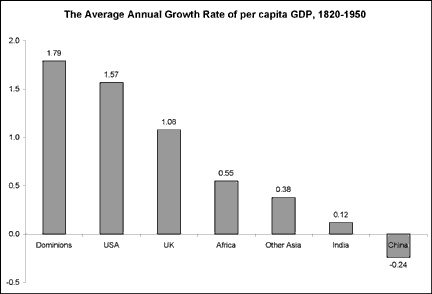 Figure 6
Figure 6
But the performance
of the dominions was not matched in the rest of the Empire and least of all in
Asia. Why was Indian economic performance so much worse
than that of the dominions?
India attracted
£286 million of capital raised in
London between 1865 and 1914—18% of
the total placed in the empire, second only to
Canada. Yet
Indian per capita GDP grew at a miserably slow rate. Between 1857 and
1947—between the Mutiny and
Independence, in other words—Indian
per capita GDP grew by just 19%, compared with an increase in
Britain of 134%.
The chart shows that between 1820 and 1950, it grew at a mere 0.12% per
annum—barely at all by the standards of the “white” empire, and slow even by
comparison with Africa.
The nationalist
explanation for Indian “underdevelopment” under British rule has four essential
components. First, the British de-industrialized
India by opening
it to factory-produced textiles from Lancashire, whose
manufacturers were initially protected from Indian competition until they had
established a technological lead. Second,
they imposed excessive and regressive taxation. Third, they “drained” capital
from India, even
manipulating the rupee-sterling exchange rate to their own advantage. Finally,
they did next to nothing to alleviate the famines that these policies caused.
One recent historian has gone so far as to speak of “Late Victorian Holocausts”
in the 1870s and 1890s.[17] This negative view of the British role in
India—which can
be traced back to Dadabhai Naoroji’s Poverty and Un-British Rule in India
(1901)—continues to enjoy wide currency.[18]
No doubt it
benefited the Indian economy little to maintain one of the world’s largest
standing armies as a mercenary force. Yet recent research casts doubt on other
aspects of the nationalist critique. Tirthankar Roy
has shown that the destruction of jobs in the Indian textile industry was
probably inevitable, regardless of who ruled
India, and that
an equal if not greater number of new jobs were created in new economic sectors
built up by the British. Even in the case of textiles, by the 1920s the
Government of India was clearly giving preference to Indian manufacturers over
Lancashire’s mills.
Roy also casts doubt on the idea
that taxation under the British was excessive, showing that the land tax burden
fell from around 10% of net output in the 1850s to 5% by the 1930s.[19] The supposed “drain” of capital from
Indiato
Britain turns
out to have been comparatively modest: only “about 0.9-1.3% of Indian national
income from 1868 to the 1930s,” according to one estimate of the export surplus
(which was what nationalists usually had in mind).[20] In any case, so far as the Home Charges
were concerned, “a great deal of government expenditure was in fact incurred for
services that
India needed but
could not supply on her own.” Finally, “the prospect of devastating famines once
every few years was inherent in
India’s ecology
. . . . Famines were primarily environmental in origin” and after 1900 the
problem was alleviated by the greater integration of the Indian market for
foodstuffs. The Bengal famine of 1943 arose precisely
because improvements introduced under British rule collapsed under the strain of
the war.[21]
Moreover, British
rule had some distinctly positive effects. It greatly increased the importance
of trade, from between 1-2% of national income to more than 20% by 1913. The
British created an integrated Indian market: they unified weights, measures, and
the currency, abolished transit duties and introduced a “legal framework [which]
promoted private property rights and contract law more explicitly.” They
invested substantially in repairing and enlarging the country’s ancient
irrigation system: between 1891 and 1938, the acreage under irrigation more than
doubled. As is well known, the British transformed the Indian system of
communications, introducing a postal and telegraph system, deploying steamships
on internal waterways and building more than 40,000 miles of railway track
(roughly five times the amount constructed in
Chinain the same
period). The railway network alone employed more than a million people by the
last decade of British rule. Finally, there was a significant increase in
financial intermediation. As Roy
concludes:
The railways,
the ports, major irrigation systems, the telegraph, sanitation and medical care,
the universities, the postal system, the courts of law, were assets
India could not
believably have acquired in such extent and quality had it not developed close
political links with
Britain . . . .
British rule appears to have done far more than what its predecessor regimes and
contemporary Indian regimes were able to do.[22]
By comparison with
the other major Asian
empire—China,
which remained under Asian political
control—Indiafared
well. The Chinese economy shrank, even if some of its troubles can doubtless be
attributed to the disruptive influence of informal European
imperialism.
The explanation for
the disappointing impact of these improvements on per capita incomes lies not in
British exploitation, but rather in the insufficient scale of British
interference in the Indian economy. The British expanded Indian education—but
not enough to make a real impact on the quality of human capital. The number of
educated Indians may have increased sevenfold between 1881 and 1941, but the
proportion of the population with primary or secondary educations was far below
European rates (2% in
India in 1913,
compared with 16% in
Britain). The
British invested in India—but not enough to pull most Indian farmers up off the
base line of subsistence, and certainly not enough to compensate for the
pitifully low level of indigenous net capital formation, worsened by the custom
of hoarding gold. The British built hospitals and banks—but not enough of them
to make significant improvements in public health and credit networks. These
were sins of omission more than commission. Unfortunately for Indians, the
nationalists who came to power in 1947 drew almost completely the wrong
conclusions about what had gone wrong under British rule, embarking instead on a
program of sub-Soviet state-led autarky whose achievement was to widen still
further the gap between Indian and British incomes, which reached its widest
historic extent in 1973.
* * *
Economic historians
continue to debate the causes of the “great divergence” of economic fortunes
which has characterized the last half millennium. In this debate, the role of
colonialism—and specifically the British Empire—has a
crucial role to play. If geography, climate, and disease provide a sufficient
explanation for the widening of global inequalities, then the policies and
institutions exported by British imperialism were of marginal importance; the
agricultural, commercial, and industrial technologies developed in
Europe from 1700 onward were bound to work better in
temperate regions with good access to sea routes. However, if the key to
economic success lies in the adoption of legal, financial, and political
institutions favorable to technical innovation and capital
accumulation—regardless of location, mean temperature, and longevity—then it
matters a great deal that by the end of the 19th century a quarter of the world
was under British rule. According to Daron Acemoglu, Simon Johnson, and James Robinson, “societies
where colonialism led to the establishment of good institutions prospered
relative to those where colonialism imposed extractive institutions.”[23] Where colonizing powers encountered
relatively advanced economies—as measured by the density of population—the
institutions imposed were essentially those of plunder and exaction. These
institutions were unlikely to foster long-run growth, and indeed had the effect
of impoverishing the conquered. But in less densely populated, poorer societies,
the colonizers had to start more or less from scratch. That was why Western
European style institutions were more likely to be introduced in
North America or
Australia than
in Central America.
In all likelihood,
the dichotomy between geography and institutions is a false one. The British
settled in large numbers in temperate zones, taking their institutions with
them; in the tropics, they preferred to rely on monopoly companies and
plantations run in (unequal) partnership with indigenous elites. But by the last
third of the 19th century this distinction had faded somewhat. Even in the
tropics, the British endeavored to introduce the institutions that they regarded
as essential to prosperity: free trade, free (and indeed forced) migration,
infrastructural investment, balanced budgets, sound money, the rule of law, and
incorrupt administration. If the results were much less impressive in Africa and
India than they were in the colonies of British settlement, that was because
even the best institutions work less well in landlocked, excessively hot, or
disease-ridden places. There, the investments which were needed to overcome
geography, climate, and their attendant deleterious effects on human capital
were beyond the imaginings of colonial rulers schooled in the Gladstonian fiscal tradition.
Perhaps they are
beyond our imaginings, too. It is far from clear that the very different
policies adopted by post-independence governments and international agencies
have been more successful. A simple calculation of the ratio of British per
capita GDP to that of forty-one former colonies is instructive. Between 1960 and
1990 the gap between the British and their former subjects narrowed in just
fourteen cases (see Figure 7).[24] While it is convenient for contemporary
rulers in countries like
Zimbabwe to
blame their problems on the “legacy of British rule,” the reality is that
British rule was on balance conducive to economic growth. Tragically, most
post-independence governments have failed to improve on it.
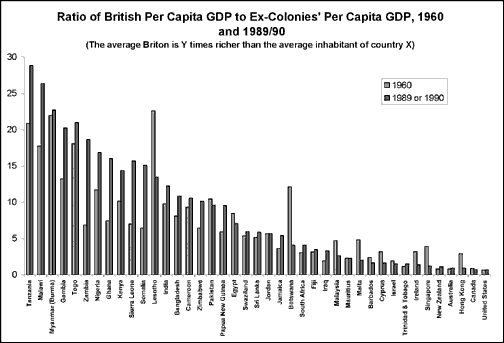 Figure 7
Figure 7
©Niall Ferguson
2003
Niall Ferguson
is professor of financial history at New York University’s Stern Business
School and senior research fellow at Jesus College,
Oxford
University. His most
recent books are Empire: The Rise and Demise of the British World Order and
Its Lessons for Global Power (Basic Books, 2003) and Empire: How Britain
Made the Modern World (Allen Lane, 2003), the latter of which was published
to coincide with a television history of the British Empire broadcast in January
2003.
[1] Lance E. Davis and R.A. Huttenback, Mammon and the Pursuit of Empire: The
Political Economy of British Imperialism, 1860-1912 (Cambridge University
Press, 1986), 107.
[2] Patrick K. O’Brien,
“Imperialism and the Rise and Decline of the British Economy, 1688-1989,” New
Left Review 238 (1999): 56, 65f, 75.
[3] B. R. Tomlinson,
“Imperialism and After: The Economy of the Empire on the Periphery,” in Judith
M. Brown and Wm.Roger Louis, eds., The
Oxford History of the
British Empire, vol. IV: The
Twentieth Century (Oxford University Press, 1999), 375.
[4] Jeffrey D. Sachs and
A. M. Warner, “Economic Reform and the Process of Global Integration,”
Brookings Papers on Economic Activity 1 (1995): 6-10, 35.
[5] Jeffrey G. Williamson,
“Winners and Losers Over Two Centuries of Globalization,” National Bureau of
Economic Research (NBER) Working Paper 9161 (2002).
[6]For a discussion, see
Michael A. Clemens and Jeffrey G. Williamson, “Where did British Capital Go?
Fundamentals, Failures, and the Lucas Paradox: 1870-1913,” NBER Working
Paper 8028 (2000).
[7] Clemens and
Williamson, “Where did British Foreign Capital Go?”
[8] Maurice Obstfeld and Alan M. Taylor, “Globalization and Capital
Markets,” NBER Working Paper 8846 (2002): 60, figure 10; table 2.
However, Obstfeld and Taylor follow Michael D. Bordo in identifying the spread of the gold standard as the
explanation: Maurice Obstfeld, and Alan M. Taylor,
“Sovereign Risk, Credibility and the Gold Standard: 1870-1913 versus 1925-31,”
NBER Working Paper 9345 (2002).
[9] Robert J. Barro, “Determinants of Economic Growth: A Cross-Country
Empirical Study,” NBER Working Paper 5698 (1996).
[10]David S. Landes, The Wealth and Poverty of Nations (Norton,
1998), 217f.
[11] Michael Edelstein, “Imperialism:
Cost and Benefit,” in Roderick Floud and Donald
McCloskey, eds., The Economic History of
Britain
since 1700, vol. II: 1860-1939, 2nd ed. (Cambridge University Press,
1994), 205.
[12]Jeffrey G.
Williamson, “Land, Labor, and Globalization in the
Pre-Industrial Third World,” NBER Working Paper 7784
(2000).
[13] The definitive
statement is in Michael D. Bordo and Hugh Rockoff, “The Gold Standard as a ‘Good Housekeeping Seal of
Approval,’” Journal of Economic History 56 (1996), reprinted in Bordo, The Gold Standard and Related Regimes
(Cambridge University Press, 1999), 149-178.
[14] Michael D. Bordo and Finn E. Kydland, “The
Gold Standard as a Commitment Mechanism,” in Tamim
Bayoumi, Barry Eichengreen,
and Mark P. Taylor, eds., Modern Perspectives on the Gold Standard
(Cambridge University Press, 1996), 55-100.
[15] P. J. Cain and A. G.
Hopkins, British Imperialism, 1688-2000, 2nd ed. (Longman, 2001), 439,
570, 584f, 233.
[16] Cain and
Hopkins, British Imperialism,
439, 567.
[17]Mike Davis, Late
Victorian Holocausts: El Nino Famines and the Making of the
Third World (Verso, 2001).
[18] See e.g. Tapan Raychaudhuri, “British Rule
in India: An Assessment,” in P. J. Marshall, ed., The Cambridge Illustrated
History of the British Empire (Cambridge University Press, 1996), 361-4;
Simon Schama, A History of Britain, vol. III:
The Fate of Empire (Miramax, 2002), esp. 359-64.
[19] Tirthankar Roy, The Economic History of
India
, 1857-1947 (Oxford
UniversityPress, 2000), 42ff,
250.
[20] Angus Maddison, The World Economy: A Millennium Perspective
(OECD, 2001), table 2-21b.
[21]
Roy, Economic History, 241,
22, 219f., 254, 285, 294.
[22]
Roy, Economic History, 32-6,
215, 258-263, 46f.
[23] Daron Acemoglu, Simon Johnson, and
James A. Robinson, “Reversal of Fortune: Geography and Institutions in the
Making of the Modern World Income Distribution,” NBER Working Paper 8460
(2001): 5.
[24] They are:
Lesotho,
Pakistan,
Egypt,
Botswana,
Malaysia,
Malta,
Barbados,
Cyprus,
Israel,
Ireland,
Singapore,
Hong Kong,
Canada, and the
United States:
figures from Maddison, World
Economy.
 Figure
1
Figure
1 
 Figure 3
Figure 3  Figure 4
Figure 4
 Figure 6
Figure 6  Figure 7
Figure 7